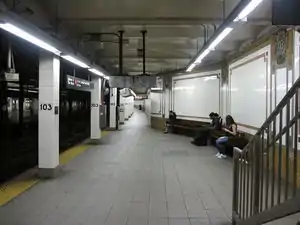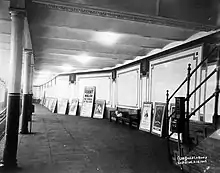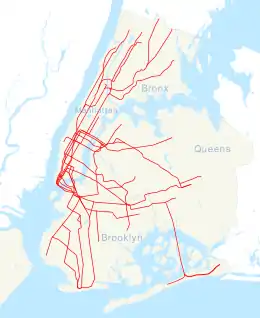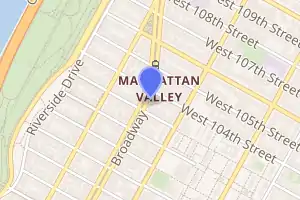103rd Street station (IRT Broadway–Seventh Avenue Line)
103rd Street is a local station on the IRT Broadway–Seventh Avenue Line of the New York City Subway. Located at the intersection of 103rd Street and Broadway on the Upper West Side of Manhattan, within Manhattan Valley, it is served by the 1 train at all times.
103 Street | ||||||||||||||||||||||||||||||||||||||||||||||||||||||||||||||||||||
|---|---|---|---|---|---|---|---|---|---|---|---|---|---|---|---|---|---|---|---|---|---|---|---|---|---|---|---|---|---|---|---|---|---|---|---|---|---|---|---|---|---|---|---|---|---|---|---|---|---|---|---|---|---|---|---|---|---|---|---|---|---|---|---|---|---|---|---|---|
 Northbound platform | ||||||||||||||||||||||||||||||||||||||||||||||||||||||||||||||||||||
| Station statistics | ||||||||||||||||||||||||||||||||||||||||||||||||||||||||||||||||||||
| Address | West 103rd Street & Broadway New York, NY 10025[1] | |||||||||||||||||||||||||||||||||||||||||||||||||||||||||||||||||||
| Borough | Manhattan | |||||||||||||||||||||||||||||||||||||||||||||||||||||||||||||||||||
| Locale | Upper West Side, Manhattan Valley | |||||||||||||||||||||||||||||||||||||||||||||||||||||||||||||||||||
| Coordinates | 40.799419°N 73.968158°W | |||||||||||||||||||||||||||||||||||||||||||||||||||||||||||||||||||
| Division | A (IRT) | |||||||||||||||||||||||||||||||||||||||||||||||||||||||||||||||||||
| Line | IRT Broadway–Seventh Avenue Line | |||||||||||||||||||||||||||||||||||||||||||||||||||||||||||||||||||
| Services | 1 | |||||||||||||||||||||||||||||||||||||||||||||||||||||||||||||||||||
| Transit | ||||||||||||||||||||||||||||||||||||||||||||||||||||||||||||||||||||
| Structure | Underground | |||||||||||||||||||||||||||||||||||||||||||||||||||||||||||||||||||
| Platforms | 2 side platforms | |||||||||||||||||||||||||||||||||||||||||||||||||||||||||||||||||||
| Tracks | 3 (2 in regular service) | |||||||||||||||||||||||||||||||||||||||||||||||||||||||||||||||||||
| Other information | ||||||||||||||||||||||||||||||||||||||||||||||||||||||||||||||||||||
| Opened | October 27, 1904[3] | |||||||||||||||||||||||||||||||||||||||||||||||||||||||||||||||||||
| Station code | 309[4] | |||||||||||||||||||||||||||||||||||||||||||||||||||||||||||||||||||
| Opposite- direction transfer | Yes | |||||||||||||||||||||||||||||||||||||||||||||||||||||||||||||||||||
| Traffic | ||||||||||||||||||||||||||||||||||||||||||||||||||||||||||||||||||||
| 2019 | 3,766,055[5] | |||||||||||||||||||||||||||||||||||||||||||||||||||||||||||||||||||
| Rank | 131 out of 424[5] | |||||||||||||||||||||||||||||||||||||||||||||||||||||||||||||||||||
| Station succession | ||||||||||||||||||||||||||||||||||||||||||||||||||||||||||||||||||||
| Next north | Cathedral Parkway–110th Street: 1 | |||||||||||||||||||||||||||||||||||||||||||||||||||||||||||||||||||
| Next south | 96th Street: 1 | |||||||||||||||||||||||||||||||||||||||||||||||||||||||||||||||||||
| ||||||||||||||||||||||||||||||||||||||||||||||||||||||||||||||||||||
| ||||||||||||||||||||||||||||||||||||||||||||||||||||||||||||||||||||
| ||||||||||||||||||||||||||||||||||||||||||||||||||||||||||||||||||||
| ||||||||||||||||||||||||||||||||||||||||||||||||||||||||||||||||||||
Built for the Interborough Rapid Transit Company (IRT), the 103rd Street station was constructed as part of the city's first subway line, which was approved in 1900. Construction on the segment of the line that includes 103rd Street started on August 22 of the same year. The station opened on October 27, 1904, as one of the original 28 stations of the New York City Subway. The station's platforms were lengthened in 1948, and the station was renovated in the 2000s.
The 103rd Street station contains two side platforms and three tracks; the center track is not used in regular service. The station was built with tile and mosaic decorations. The mezzanine above the platforms contains exits to 103rd Street and Broadway.
History
Construction and opening

Planning for the city's first subway line dates to the Rapid Transit Act, authorized by the New York State Legislature in 1894.[6]:139–140 The subway plans were drawn up by a team of engineers led by William Barclay Parsons, chief engineer of the Rapid Transit Commission. It called for a subway line from New York City Hall in lower Manhattan to the Upper West Side, where two branches would lead north into the Bronx.[7]:3 A plan was formally adopted in 1897, and legal challenges were resolved near the end of 1899.[6]:148 The Rapid Transit Construction Company, organized by John B. McDonald and funded by August Belmont Jr., signed Contract 1 with the Rapid Transit Commission in February 1900,[8] in which it would construct the subway and maintain a 50-year operating lease from the opening of the line.[6]:182 In 1901, the firm of Heins & LaFarge was hired to design the underground stations.[7]:4 Belmont incorporated the Interborough Rapid Transit Company (IRT) in April 1902 to operate the subway.[6]:182
The 103rd Street station was constructed as part of the IRT's West Side Line (now the Broadway–Seventh Avenue Line) from 82nd Street to 104th Street, for which construction began on August 22, 1900.[8] The section of the West Side Line around this station was originally planned as a two-track line, but in early 1901, was changed to a three-track structure to allow trains to be stored in the center track.[9]:93[10]:189–190 A third track was added directly north of 96th Street, immediately east of the originally planned two tracks.[11]:14 The 103rd Street station opened on October 27, 1904, as one of the original 28 stations of the New York City Subway from City Hall to 145th Street on the West Side Branch.[6]:186[3]
20th century
After the initial system was completed in 1908,[12] the station was served by West Side local and express trains. Express trains began at South Ferry in Manhattan or Atlantic Avenue in Brooklyn, and ended at 242nd Street in the Bronx. Local trains ran from City Hall to 242nd Street during rush hours, continuing south from City Hall to South Ferry at other times.[13] In 1918, the Broadway–Seventh Avenue Line opened south of Times Square–42nd Street, thereby dividing the original line into an "H" system. Local trains were sent to South Ferry, while express trains used the new Clark Street Tunnel to Brooklyn.[14]
In 1909, to address overcrowding, the New York Public Service Commission proposed lengthening platforms at stations along the original IRT subway.[15]:168 On January 18, 1910, a modification was made to Contracts 1 and 2 to lengthen station platforms to accommodate ten-car express and six-car local trains. In addition to $1.5 million (equivalent to $41.2 million in 2019) spent on platform lengthening, $500,000 (equivalent to $13,719,643 in 2019) was spent on building additional entrances and exits. It was anticipated that these improvements would increase capacity by 25 percent.[16]:15 On September 30, 1910, the New York Public Service Commission approved a modification to Contract 1 to allow for the construction of additional entrances and exits at five stations, including 103rd Street and 110th Street on Broadway. Work was expected to be completed within a year of the date that permission was granted to do the work at these two stations.[17] The northbound platform at the 103rd Street station was extended 125 feet (38 m) to the north,[16]:111 while the southbound platform was not lengthened.[16]:106 On January 24, 1911, ten-car express trains began running on the West Side Line.[15]:168[18] In conjunction with the platform lengthening, a new entrance was constructed at the southeast corner of 104th Street and Broadway, and was completed in March 1912. The kiosk for this entrance had previously been in use at an entrance at the southeast corner of Broadway and 42nd Street, but was removed to allow for the widening of 42nd Street.[19] In 1920, an additional exit was constructed at 103rd Street in case of emergencies.[20] In 1930, the kiosk for the entrance at the southeastern corner of 104th Street and Broadway was removed.[21]
In 1948, platforms on the IRT Broadway–Seventh Avenue Line from 103rd Street to 238th Street were lengthened to 514 feet (157 m) to allow full ten-car express trains to stop at this station. Previously, the station could accommodate six-car local trains, but ten-car trains could not open some of their doors. The platform extensions at these stations were opened in stages. On April 6, 1948, the platform extension at 103rd Street opened.[22] Simultaneously, the IRT routes were given numbered designations with the introduction of "R-type" rolling stock. The first such fleet, the R12, was put into service in 1948.[23] The Broadway/West Side route to 242nd Street became known as the 1.[24] In 1959, all 1 trains became local.[25]
On October 17, 1969, the New York City Transit Authority (NYCTA) adopted a contract for a project to remove the station's original entrance in the center mall of Broadway at 103rd Street with new entrances on the sidewalk so it could be put out for bidding. The project was intended to allow passengers to enter the station without having to cross Broadway.[26]
In 1979, the New York City Landmarks Preservation Commission (LPC) designated space within the boundaries of the original stations at twelve IRT stations, excluding expansions made after 1904, as a city landmark.[7][27] 103rd Street was not landmarked, unlike the 110th Street and 116th Street stations on the line, not because of a dearth of historic architecture, but as part of an compromise between the Metropolitan Transportation Authority (MTA) and the LPC.[28]
In April 1988,[29] the NYCTA unveiled plans to speed up service on the Broadway–Seventh Avenue Line through the implementation of a skip-stop service: the 9 train.[30] When skip-stop service started in 1989, it was only implemented north of 137th Street–City College on weekdays, and 103rd Street was served by both the 1 and the 9.[31][32][33]
21st century
In June 2002, the MTA announced that ten subway stations citywide, including 103rd Street, 110th Street, 116th Street, 125th Street, and 231st Street on the IRT Broadway–Seventh Avenue Line, would receive renovations. As part of the project, fare control areas would be redesigned, flooring, and electrical and communication systems would be upgraded, and new lighting, public address systems and stairways would be installed. Historical elements at the four stations on the line in Manhattan would be replaced or restored, including their white wall tiles. At the ends of the station platforms at 103rd Street, 110th Street, and 116th Street, a small section of station wall, which would look identical to the existing station walls, would be added to provide space for scrubber rooms.[34][28] Work on the ten citywide renovation projects was estimated to cost almost $146 million, and was scheduled to start later that year, and be completed in April 2004, in time for the 100th anniversary of the station's opening, and the 250th anniversary of Columbia University.[35][36]
Columbia University agreed to contribute $1 million to the renovation of the 103rd Street station following its announcement in April that it would purchase a building adjacent to that station. As a condition of the funding allocation for the station renovation at 103rd Street, the university wanted work on the project to be expedited. Residents of Morningside Heights approved of the renovation plans, but were concerned that the expedited repairs would come at the cost of damaging the stations' historic elements. Block associations near the 103rd Street station contracted a firm to develop a plan to renovate the station quickly while maintaining its historic elements. The MTA was expected to decide whether preservation or speed would be prioritized in the station renovation projects by the end of the year.[34]
In December 2002, Manhattan Community Board 7 voted in favor of the plan to include artwork from the MTA's Arts for Transit program at the 103rd Street station, which was not landmarked. Community Board 7 voted against the plan to include new artwork at the landmarked 110th Street and 116th Street stations.[37] On February 4, 2003, Community Board 7 voted in favor of renovating the 103rd Street and 110th Street stations, but against the inclusion of any new artwork in the stations, going against the board's initial vote to support the installation of artwork at 103rd Street. The opposition to the addition of artwork at that stop stemmed from the belief among opponents of the plan for artwork that the station's historic features would be more vulnerable as the station was not landmarked.[28] From May 31 to July 12, 2003, the uptown platforms at the 116th Street and 103rd Street stations were closed at all times for their renovations.[38] Skip-stop service ended on May 27, 2005.[39][40]
Station layout
| G | Street level | Exit/entrance |
| M | Mezzanine | Fare control, station agent, MetroCard machines |
| P Platform level |
Side platform | |
| Northbound local | ← | |
| Peak-direction express | No regular service | |
| Southbound local | | |
| Side platform | ||
This station was part of the original subway, and has two side platforms and three tracks, the center one being an unused express track.[41] The platforms were originally 350 feet (110 m) long, as at other stations north of 96th Street,[7]:4[42]:8 but as a result of the 1948 platform extension, became 520 feet (160 m) long.[22] The platform extensions are at the southern ends of the original platforms.[42]:39 There is a mezzanine above the platforms, which contains the fare control area, as well as stairs to the street and both platforms.
The southbound local track is known as BB1 and the northbound one is BB4; the BB designation is used for chaining purposes along the Broadway–Seventh Avenue Line from 96th Street to 242nd Street and not in everyday speech. Although it cannot be accessed at 103rd Street, the center track is designated as M.[41] South of the station, there are switches that connect the express track to either local track, with trains then being able to cross over to the rising express tracks from the IRT Lenox Avenue Line, which curve from 104th Street in the east.[41] An emergency exit from the Lenox Avenue Line is located in the middle of the northbound platform.
Design
As with other stations built as part of the original IRT, the tunnel is covered by a "U"-shaped trough that contains utility pipes and wires. The bottom of this trough contains a foundation of concrete no less than 4 inches (100 mm) thick.[42]:9 Each platform consists of 3-inch-thick (7.6 cm) concrete slabs, beneath which are drainage basins. The original platforms contain circular, cast-iron Doric-style columns spaced every 15 feet (4.6 m), while the platform extensions contain I-beam columns. Additional columns between the tracks, spaced every 5 feet (1.5 m), support the jack-arched concrete station roofs.[7]:4[42]:9 There is a 1-inch (25 mm) gap between the trough wall and the platform walls, which are made of 4-inch (100 mm)-thick brick covered over by a tiled finish.[42]:9
The decorative scheme consists of green tile tablets; green, pink, and red tile bands; a yellow faience cornice; and blue faience plaques. The decorative work was performed by tile contractor Alfred Boote Company and faience contractor Grueby Faience Company.[42]:39
Exits

The station has four entrance/exit stairs that serve both platforms. Two are on the northwest corner of Broadway and 103rd Street and two are on the northeastern corner of the same intersection. A fifth, exit-only stair leads from the northbound platform to the southeastern corner of Broadway and 104th Street.[43]
There was a control house in the median of Broadway, just north of 103rd Street, which was designed by Heins & LaFarge and dated to the station's opening in 1904.[44] It was built as one of several station houses on the original IRT; similar station houses were built at Atlantic Avenue, Bowling Green, Mott Avenue, 72nd Street, and 116th Street.[45]:46[46]:2 The station house, which was identical to one at 116th Street, occupied an area of 50 by 20 feet (15.2 by 6.1 m). The one-story station house contained exterior walls made of buff brick, with a foundation made of granite blocks. A limestone string course ran atop the exterior wall. At the corners of the station house were limestone quoins, which supported a copper-and-terracotta gable roof facing west and east. The ridge of the station house's roof was a skylight made of glass and metal. The doorways were centrally located on the north and south walls of the control house, topped by terracotta finials and a rounded gable. There were terracotta crosses on each rounded gable with the number "103" embossed onto them. Above the doorway was a pediment and an arched window made of glass and wrought iron.[42]:12 It was closed and eventually demolished in 1969.[26]
In popular culture
The 103rd Street station was one of the settings in the William S. Burroughs book Junkie and was briefly featured in the film Black Swan.[47]
References
- "Borough of Manhattan, New York City". Government of New York City. Retrieved December 28, 2020.
- "Manhattan Bus Map" (PDF). Metropolitan Transportation Authority. July 2019. Retrieved December 1, 2020.
- "Our Subway Open: 150,000 Try It; Mayor McClellan Runs the First Official Train". The New York Times. October 28, 1904. p. 1. ISSN 0362-4331. Retrieved April 21, 2020.
- "Station Developers' Information". Metropolitan Transportation Authority. Retrieved June 13, 2017.
- "Facts and Figures: Annual Subway Ridership 2014–2019". Metropolitan Transportation Authority. 2020. Retrieved May 26, 2020.
- Walker, James Blaine (1918). Fifty Years of Rapid Transit — 1864 to 1917. New York, N.Y.: Law Printing. Retrieved November 6, 2016.
- "Interborough Rapid Transit System, Underground Interior" (PDF). New York City Landmarks Preservation Commission. October 23, 1979. Retrieved November 19, 2019.
- Report of the Board of Rapid Transit Railroad Commissioners for the City of New York For The Year Ending December 31, 1904 Accompanied By Reports of the Chief Engineer and of the Auditor. Board of Rapid Transit Railroad Commissioners. 1905. pp. 229–236.
- Report of the Board of Rapid Transit Railroad Commissioners For And In The City of New York Up to December 31, 1901. Board of Rapid Transit Railroad Commissioners. 1902.
- Report of the Public Service Commission For The First District of the State of New York For The Year Ending December 31, 1909. Albany: Public Service Commission. 1910.
- "New York City's Subway Turns 100" (PDF). The Bulletin. Electric Railroaders' Association. 47 (10). October 2004. Archived from the original (PDF) on April 3, 2018. Retrieved April 2, 2018.
- "Our First Subway Completed At Last — Opening of the Van Cortlandt Extension Finishes System Begun in 1900 — The Job Cost $60,000,000 — A Twenty-Mile Ride from Brooklyn to 242d Street for a Nickel Is Possible Now". The New York Times. August 2, 1908. p. 10. Retrieved November 6, 2016.
- Brooklyn Daily Eagle Almanac. Brooklyn Daily Eagle. 1916. p. 119.
- "Open New Subway Lines to Traffic; Called a Triumph" (PDF). The New York Times. August 2, 1918. p. 1. ISSN 0362-4331. Retrieved October 4, 2011.
- Hood, Clifton (1978). "The Impact of the IRT in New York City" (PDF). Historic American Engineering Record. pp. 146–207 (PDF pp. 147–208). Retrieved December 20, 2020.
 This article incorporates text from this source, which is in the public domain.
This article incorporates text from this source, which is in the public domain. - Report of the Public Service Commission for the First District of the State of New York For The Year Ending December 31, 1910. Public Service Commission. 1911.
- Proceedings of the Public Service Commission For The First District State of New York Volume V From January 3 to December 31, 1910 (With Index). New York State Public Service Commission. 1910. pp. 650–653.
- "Ten-car Trains in Subway to-day; New Service Begins on Lenox Av. Line and Will Be Extended to Broadway To-morrow". The New York Times. January 23, 1911. ISSN 0362-4331. Retrieved April 5, 2018.
- District, New York (State) Public Service Commission First (1913). Report of the Public Service Commission for the First District of the State of New York. The Commission. p. 163.
- 1920-1921 Annual Report of the Interborough Rapid Transit Company For The Year Ended June 30, 1921. Interborough Rapid Transit Company. 1921. p. 10.
- Commission, New York (State) Transit (1930). Proceedings of the Transit Commission, State of New York. p. 1260.
- Report for the three and one-half years ending June 30, 1949. New York City Board of Transportation. 1949. hdl:2027/mdp.39015023094926.
- Brown, Nicole (May 17, 2019). "How did the MTA subway lines get their letter or number? NYCurious". amNewYork. Retrieved January 27, 2021.
- Friedlander, Alex; Lonto, Arthur; Raudenbush, Henry (April 1960). "A Summary of Services on the IRT Division, NYCTA" (PDF). New York Division Bulletin. Electric Railroaders' Association. 3 (1): 2.
- "Wagner Praises Modernized IRT — Mayor and Transit Authority Are Hailed as West Side Changes Take Effect". The New York Times. February 7, 1959. p. 21. Retrieved November 6, 2016.
- Minutes and Proceedings of the New York City Transit Authority. New York City Transit Authority. 1969. p. 519.
- "12 IRT Subway Stops Get Landmark Status". The New York Times. October 27, 1979. ISSN 0362-4331. Retrieved December 26, 2020.
- Homans, Charlie (February 6, 2003). "CB7 Rejects MTA's Arts For Transit Proposition". Columbia Daily Spectator. Retrieved January 5, 2021.
- Brozan, Nadine (June 4, 1989). "'Skip-Stop' Subway Plan Annoys No. 1 Riders". The New York Times. ISSN 0362-4331. Retrieved June 15, 2016.
- Moore, Keith (June 10, 1988). "TA's skip-stop plan hit". New York Daily News. Retrieved November 8, 2018.
- "#1 Riders: Your Service is Changing". New York Daily News. August 20, 1989. Retrieved November 8, 2018.
- "Announcing 1 and 9 Skip-Stop Service on the Broadway-Seventh Avenue Line" (PDF). New York City Transit Authority. August 1989. Archived from the original (PDF) on June 26, 2020. Retrieved August 1, 2009.
- Lorch, Donatella (August 22, 1989). "New Service For Subways On West Side". The New York Times. ISSN 0362-4331. Retrieved June 15, 2016.
- Nowakowski, Xan (September 11, 2002). "Columbia Invests in Area Subway Stations". Columbia Daily Spectator. Retrieved January 5, 2021.
- Donohue, Pete (June 11, 2002). "Renovation Is Set For 10 Subway Stations". New York Daily News. Retrieved January 8, 2018.
- Angara, Harini (January 23, 2004). "116th Subway Station Gets a Face Lift". Columbia Spectator. Retrieved January 5, 2021.
- Homans, Charlie (January 24, 2003). "Tunnel Vision: MTA, Locals Don't See Eye to Eye". Columbia Daily Spectator. Retrieved January 5, 2021.
- "1 9 Uptown Platforms at 103 St. and 116 St. will be closed". Columbia Daily Spectator. May 28, 2003. Retrieved January 5, 2021.
- Chan, Sewell (May 25, 2005). "On Its Last Wheels, No. 9 Line Is Vanishing on Signs". The New York Times. ISSN 0362-4331. Retrieved August 29, 2016.
- "Noteworthy - 9 discontinued". May 7, 2005. Archived from the original on May 7, 2005. Retrieved September 18, 2016.
- Dougherty, Peter (2006) [2002]. Tracks of the New York City Subway 2006 (3rd ed.). Dougherty. OCLC 49777633 – via Google Books.
- Framberger, David J. (1978). "Architectural Designs for New York's First Subway" (PDF). Historic American Engineering Record. pp. 1-46 (PDF pp. 367-412). Retrieved December 20, 2020.
 This article incorporates text from this source, which is in the public domain.
This article incorporates text from this source, which is in the public domain. - "MTA Neighborhood Maps: 103rd Street (1)". mta.info. Metropolitan Transportation Authority. April 2018. Retrieved January 5, 2021.
- "Heins & LaFarge original plans, elevations and sections for the 103rd Street IRT Station".
- Stern, Robert A. M.; Gilmartin, Gregory; Massengale, John Montague (1983). New York 1900: Metropolitan Architecture and Urbanism, 1890-1915. New York: Rizzoli. ISBN 0-8478-0511-5. OCLC 9829395.
- "Interborough Rapid Transit System, 72nd Street Control House" (PDF). New York City Landmarks Preservation Commission. January 9, 1979. Retrieved November 19, 2019.
- "Filming Locations for Black Swan (2010) around New York". The Worldwide Guide to Movie Locations. Archived from the original on July 29, 2019. Retrieved March 29, 2020.
Further reading
External links
| Wikimedia Commons has media related to 103rd Street (IRT Broadway – Seventh Avenue Line). |
- nycsubway.org – IRT West Side Line: 103rd Street
- Station Reporter – 1 Train
- Forgotten NY – "Original 28 - NYC's First 28 Subway Stations". forgotten-ny.com. Archived from the original on December 24, 2006. Retrieved April 2, 2012.
- 103rd Street entrance from Google Maps Street View
- Platforms from Google Maps Street View





